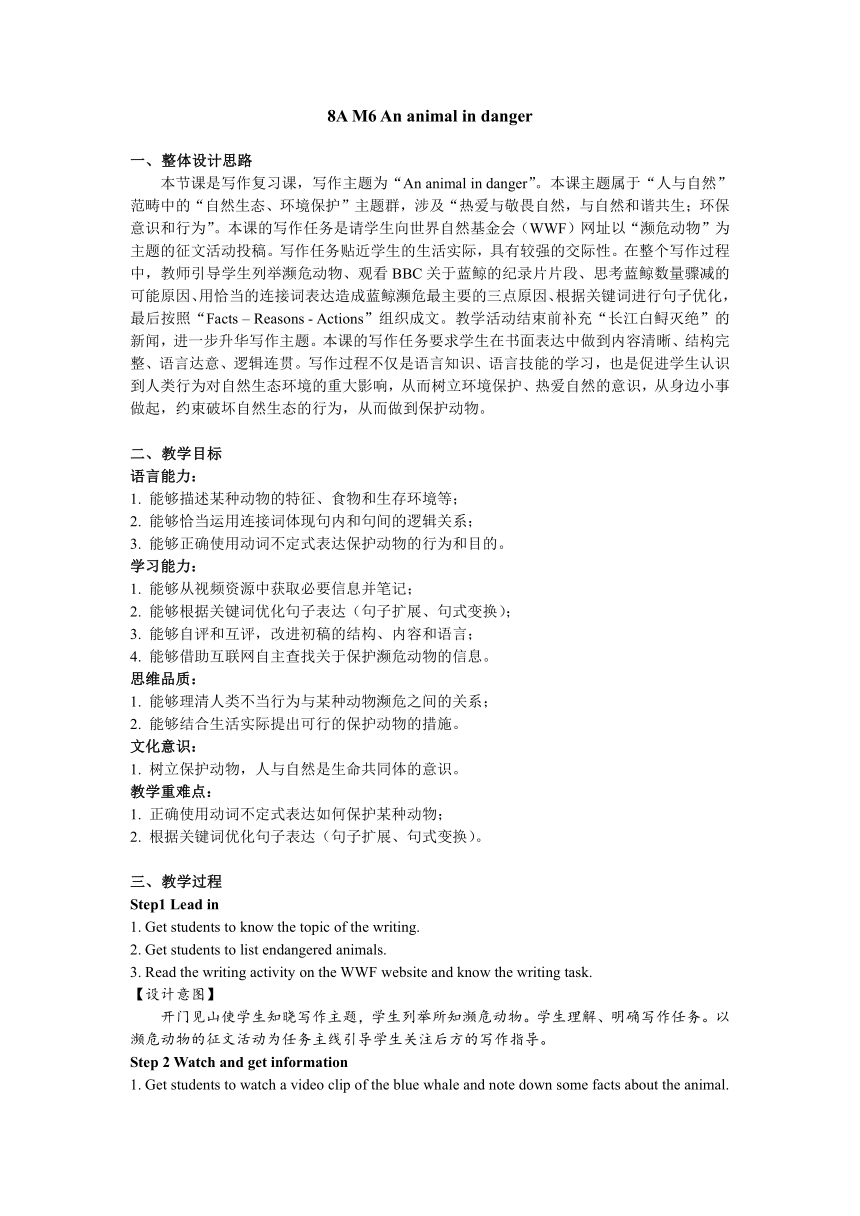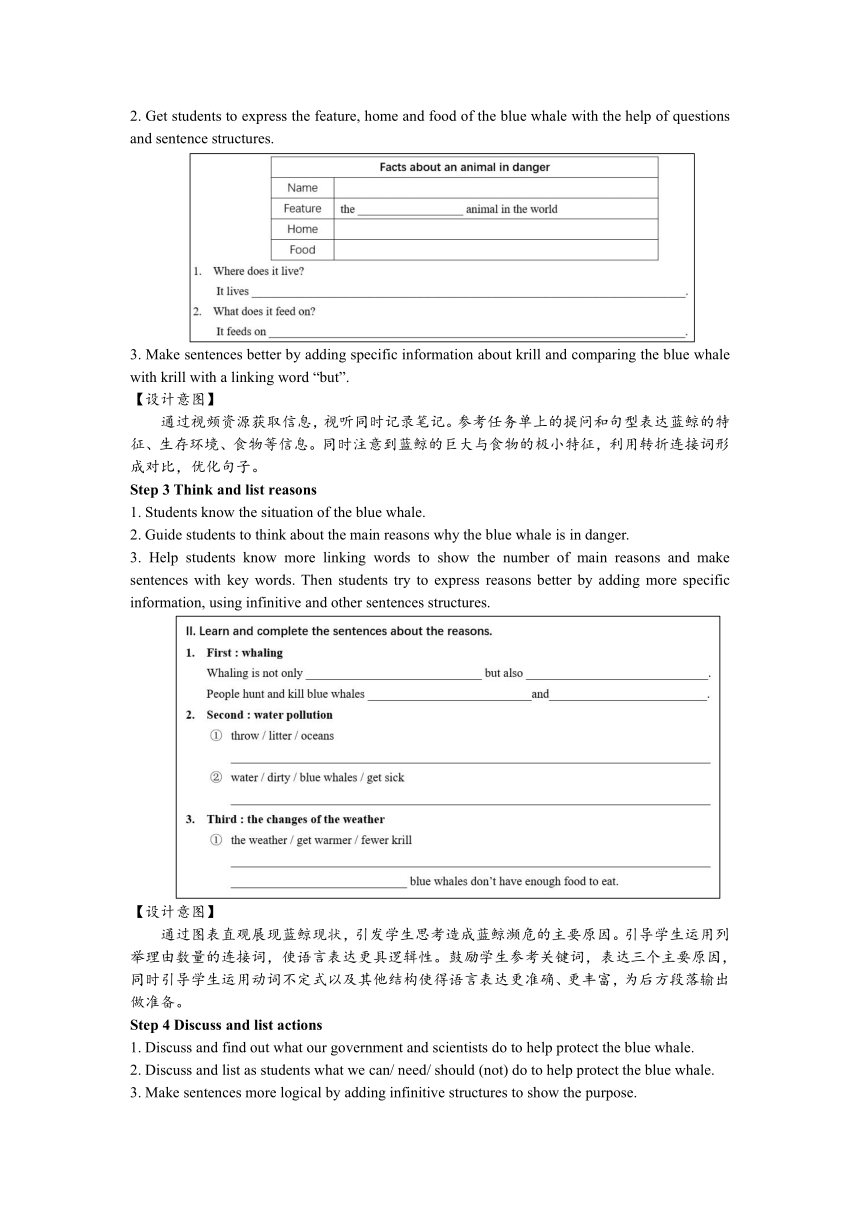八年级上册 Module 6 Animals in danger 写作课复习教学设计
文档属性
| 名称 | 八年级上册 Module 6 Animals in danger 写作课复习教学设计 |

|
|
| 格式 | docx | ||
| 文件大小 | 604.0KB | ||
| 资源类型 | 教案 | ||
| 版本资源 | 外研版 | ||
| 科目 | 英语 | ||
| 更新时间 | 2023-05-21 07:13:37 | ||
图片预览


文档简介
8A M6 An animal in danger
整体设计思路
本节课是写作复习课,写作主题为“An animal in danger”。本课主题属于“人与自然”范畴中的“自然生态、环境保护”主题群,涉及“热爱与敬畏自然,与自然和谐共生;环保意识和行为”。本课的写作任务是请学生向世界自然基金会(WWF)网址以“濒危动物”为主题的征文活动投稿。写作任务贴近学生的生活实际,具有较强的交际性。在整个写作过程中,教师引导学生列举濒危动物、观看BBC关于蓝鲸的纪录片片段、思考蓝鲸数量骤减的可能原因、用恰当的连接词表达造成蓝鲸濒危最主要的三点原因、根据关键词进行句子优化,最后按照“Facts – Reasons - Actions”组织成文。教学活动结束前补充“长江白鲟灭绝”的新闻,进一步升华写作主题。本课的写作任务要求学生在书面表达中做到内容清晰、结构完整、语言达意、逻辑连贯。写作过程不仅是语言知识、语言技能的学习,也是促进学生认识到人类行为对自然生态环境的重大影响,从而树立环境保护、热爱自然的意识,从身边小事做起,约束破坏自然生态的行为,从而做到保护动物。
教学目标
语言能力:
1. 能够描述某种动物的特征、食物和生存环境等;
2. 能够恰当运用连接词体现句内和句间的逻辑关系;
3. 能够正确使用动词不定式表达保护动物的行为和目的。
学习能力:
1. 能够从视频资源中获取必要信息并笔记;
2. 能够根据关键词优化句子表达(句子扩展、句式变换);
3. 能够自评和互评,改进初稿的结构、内容和语言;
4. 能够借助互联网自主查找关于保护濒危动物的信息。
思维品质:
1. 能够理清人类不当行为与某种动物濒危之间的关系;
2. 能够结合生活实际提出可行的保护动物的措施。
文化意识:
1. 树立保护动物,人与自然是生命共同体的意识。
教学重难点:
1. 正确使用动词不定式表达如何保护某种动物;
2. 根据关键词优化句子表达(句子扩展、句式变换)。
教学过程
Step1 Lead in
1. Get students to know the topic of the writing.
2. Get students to list endangered animals.
3. Read the writing activity on the WWF website and know the writing task.
【设计意图】
开门见山使学生知晓写作主题,学生列举所知濒危动物。学生理解、明确写作任务。以濒危动物的征文活动为任务主线引导学生关注后方的写作指导。
Step 2 Watch and get information
1. Get students to watch a video clip of the blue whale and note down some facts about the animal.
2. Get students to express the feature, home and food of the blue whale with the help of questions and sentence structures.
3. Make sentences better by adding specific information about krill and comparing the blue whale with krill with a linking word “but”.
【设计意图】
通过视频资源获取信息,视听同时记录笔记。参考任务单上的提问和句型表达蓝鲸的特征、生存环境、食物等信息。同时注意到蓝鲸的巨大与食物的极小特征,利用转折连接词形成对比,优化句子。
Step 3 Think and list reasons
1. Students know the situation of the blue whale.
2. Guide students to think about the main reasons why the blue whale is in danger.
3. Help students know more linking words to show the number of main reasons and make sentences with key words. Then students try to express reasons better by adding more specific information, using infinitive and other sentences structures.
【设计意图】
通过图表直观展现蓝鲸现状,引发学生思考造成蓝鲸濒危的主要原因。引导学生运用列举理由数量的连接词,使语言表达更具逻辑性。鼓励学生参考关键词,表达三个主要原因,同时引导学生运用动词不定式以及其他结构使得语言表达更准确、更丰富,为后方段落输出做准备。
Step 4 Discuss and list actions
1. Discuss and find out what our government and scientists do to help protect the blue whale.
2. Discuss and list as students what we can/ need/ should (not) do to help protect the blue whale.
3. Make sentences more logical by adding infinitive structures to show the purpose.
【设计意图】
通过讨论,学生知晓政府和科学家正在采取哪些措施保护动物。更重要的是作为学生,在日常生活和学习中如何帮助保护动物。在表达不同身份的人开展的动物保护行动时,准确使用动词不定式表目的的功能,使得句子更完整、更具逻辑性。在前方的基础上,教师指导学生组织成文。
Step 5 Structure
【设计意图】
通过展示写作框架,强化文章结构,为下方起草步骤做好准备。
Step 6 Draft writing
【设计意图】
写作起草阶段,为学生提供简单的语言支架,有利于写作能力相对薄弱的学生明确写作方向,开展写作内容,树立完成初稿的信心。
Step 7 Check and share your writing
【设计意图】
鼓励学生完成初稿后,参照评价表开展自评,以及互评活动,促进学生养成独立回顾和合作修改写作的习惯。
Step 8 Make a conclusion
1. Share sad news about the extinction of the Chinese paddlefish.
2. Emphasize the importance of protection of animals and look forward to the future.
【设计意图】
补充关于长江白鲟灭绝的事件,强化保护动物的重要性,鼓励学生从课堂学习延伸到课外,借助互联网查阅相关信息,树立人与自然是生命共同体的意识,保护动物就是保护人类自己。
整体设计思路
本节课是写作复习课,写作主题为“An animal in danger”。本课主题属于“人与自然”范畴中的“自然生态、环境保护”主题群,涉及“热爱与敬畏自然,与自然和谐共生;环保意识和行为”。本课的写作任务是请学生向世界自然基金会(WWF)网址以“濒危动物”为主题的征文活动投稿。写作任务贴近学生的生活实际,具有较强的交际性。在整个写作过程中,教师引导学生列举濒危动物、观看BBC关于蓝鲸的纪录片片段、思考蓝鲸数量骤减的可能原因、用恰当的连接词表达造成蓝鲸濒危最主要的三点原因、根据关键词进行句子优化,最后按照“Facts – Reasons - Actions”组织成文。教学活动结束前补充“长江白鲟灭绝”的新闻,进一步升华写作主题。本课的写作任务要求学生在书面表达中做到内容清晰、结构完整、语言达意、逻辑连贯。写作过程不仅是语言知识、语言技能的学习,也是促进学生认识到人类行为对自然生态环境的重大影响,从而树立环境保护、热爱自然的意识,从身边小事做起,约束破坏自然生态的行为,从而做到保护动物。
教学目标
语言能力:
1. 能够描述某种动物的特征、食物和生存环境等;
2. 能够恰当运用连接词体现句内和句间的逻辑关系;
3. 能够正确使用动词不定式表达保护动物的行为和目的。
学习能力:
1. 能够从视频资源中获取必要信息并笔记;
2. 能够根据关键词优化句子表达(句子扩展、句式变换);
3. 能够自评和互评,改进初稿的结构、内容和语言;
4. 能够借助互联网自主查找关于保护濒危动物的信息。
思维品质:
1. 能够理清人类不当行为与某种动物濒危之间的关系;
2. 能够结合生活实际提出可行的保护动物的措施。
文化意识:
1. 树立保护动物,人与自然是生命共同体的意识。
教学重难点:
1. 正确使用动词不定式表达如何保护某种动物;
2. 根据关键词优化句子表达(句子扩展、句式变换)。
教学过程
Step1 Lead in
1. Get students to know the topic of the writing.
2. Get students to list endangered animals.
3. Read the writing activity on the WWF website and know the writing task.
【设计意图】
开门见山使学生知晓写作主题,学生列举所知濒危动物。学生理解、明确写作任务。以濒危动物的征文活动为任务主线引导学生关注后方的写作指导。
Step 2 Watch and get information
1. Get students to watch a video clip of the blue whale and note down some facts about the animal.
2. Get students to express the feature, home and food of the blue whale with the help of questions and sentence structures.
3. Make sentences better by adding specific information about krill and comparing the blue whale with krill with a linking word “but”.
【设计意图】
通过视频资源获取信息,视听同时记录笔记。参考任务单上的提问和句型表达蓝鲸的特征、生存环境、食物等信息。同时注意到蓝鲸的巨大与食物的极小特征,利用转折连接词形成对比,优化句子。
Step 3 Think and list reasons
1. Students know the situation of the blue whale.
2. Guide students to think about the main reasons why the blue whale is in danger.
3. Help students know more linking words to show the number of main reasons and make sentences with key words. Then students try to express reasons better by adding more specific information, using infinitive and other sentences structures.
【设计意图】
通过图表直观展现蓝鲸现状,引发学生思考造成蓝鲸濒危的主要原因。引导学生运用列举理由数量的连接词,使语言表达更具逻辑性。鼓励学生参考关键词,表达三个主要原因,同时引导学生运用动词不定式以及其他结构使得语言表达更准确、更丰富,为后方段落输出做准备。
Step 4 Discuss and list actions
1. Discuss and find out what our government and scientists do to help protect the blue whale.
2. Discuss and list as students what we can/ need/ should (not) do to help protect the blue whale.
3. Make sentences more logical by adding infinitive structures to show the purpose.
【设计意图】
通过讨论,学生知晓政府和科学家正在采取哪些措施保护动物。更重要的是作为学生,在日常生活和学习中如何帮助保护动物。在表达不同身份的人开展的动物保护行动时,准确使用动词不定式表目的的功能,使得句子更完整、更具逻辑性。在前方的基础上,教师指导学生组织成文。
Step 5 Structure
【设计意图】
通过展示写作框架,强化文章结构,为下方起草步骤做好准备。
Step 6 Draft writing
【设计意图】
写作起草阶段,为学生提供简单的语言支架,有利于写作能力相对薄弱的学生明确写作方向,开展写作内容,树立完成初稿的信心。
Step 7 Check and share your writing
【设计意图】
鼓励学生完成初稿后,参照评价表开展自评,以及互评活动,促进学生养成独立回顾和合作修改写作的习惯。
Step 8 Make a conclusion
1. Share sad news about the extinction of the Chinese paddlefish.
2. Emphasize the importance of protection of animals and look forward to the future.
【设计意图】
补充关于长江白鲟灭绝的事件,强化保护动物的重要性,鼓励学生从课堂学习延伸到课外,借助互联网查阅相关信息,树立人与自然是生命共同体的意识,保护动物就是保护人类自己。
同课章节目录
- Module 1 How to learn English
- Unit 1 Let's try to speak English as much as possi
- Unit 2 You should smile at her.
- Unit 3 Language in use .
- Module 2 My home town and my country
- Unit 1 It's taller than many other buildings.
- Unit 2 Cambridge is a beautiful city in the east o
- Unit 3 Language in use .
- Module 3 Sports.
- Unit 1 Nothing is more exciting than playing tenni
- Unit 2 This year we training more carefully.
- Unit 3 Language in use .
- Module 4 Planes, ships and trains .
- Unit 1 He lives the farthest from school.
- Unit 2 What is the best way to travel.
- Unit 3 Language in use .
- Module 5 Lao She Teahouse.
- Unit 1 I wanted to see the Beijing Opera.
- Unit 2 It descibes the changes in Chinese society.
- Unit 3 Language in use .
- Module 6 Animals in danger.
- Unit 1 It allows people to get closer to them .
- Unit 2 The WWF is working hard to save them all.
- Unit 3 Language in use .
- Revision module A
- Module 7 A famous story
- Unit 1 Alice was sitting with her sister by the ri
- Unit 2 She was thinking about her cat.
- Unit 3 Language in use .
- Module 8 Accidents
- Unit 1 While the car were changing to red, a car s
- Unit 2 I was trying to pick it up when it bite me
- Unit 3 Language in use .
- Module 9 Population
- Unit 1 The population of China is about 1.37 billi
- Unit 2 Arnwick was a city with 200,000 people.
- Unit 3 Language in use .
- Module 10 The weathe
- Unit 1 It might snow.
- Unit 2 The weather is fine all year round.
- Unit 3 Language in use .
- Module 11 Way of life
- Unit 1 In China ,we open a gift later.
- Unit 2 In England, you usually drink tea with milk
- Unit 3 Language in use .
- Module 12 Help
- Unit 1 What should we do before help arrives?
- Unit 2 Stay away from windows and heavy furniture.
- Unit 3 Language in use .
- Revision module B
